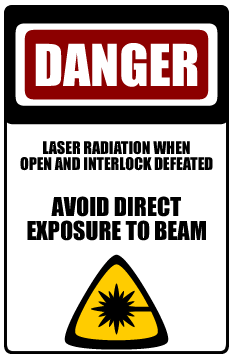Aviso de archivo
Esta es una página de archivo que ya no se actualiza. Puede contener información desactualizada y es posible que los enlaces ya no funcionen como se pretendía originalmente.
Home | Glossary | Resources | Help | Contact Us | Course Map
Even though lasers may not be a common analytical instrument in the laboratory , the indirect use of lasers in laboratory instrumentation (in the form of embedded lasers-such as the AB 310 Genetic Analyzer) deems it necessary to include laser safety as part of a safety program. The use of an alternate light source (ALS) within the laboratory also makes a laser/ALS safety program a necessity.
In general, this portion of the safety program will focus on:
- Who is affected
- Personnel responsibilities
- Laser Safety Officer
- Responsibilities of the employer, supervisors, and employees
- Laser hazard classification
- Class I, Class II, Class IIA, Class IIIA, Class IIIB, Class IV, Embedded
- Laser control measures
- Training
- Employees assigned to service, maintain, adjust, and/or operate laser/ALS equipment
- Training can be general (reading the associated equipment manuals) or specific (dealing with a particular instrument)
- Work in conjunction with the appropriate personnel to design the proper training for the equipment in use
Due to the specialized nature of lasers, the laboratory safety officer may not be able to fulfill the requirements of a laboratory laser safety officer. Therefore, it may be necessary to subcontract or work in conjunction with the municipal safety department and/or industrial hygienist. OSHA Directive PUB 8-1.7 Guidelines for Laser Safety and Hazard Assessment provides guidelines for the assessment of laser safety.22
Additional Online Courses
- What Every First Responding Officer Should Know About DNA Evidence
- Collecting DNA Evidence at Property Crime Scenes
- DNA – A Prosecutor’s Practice Notebook
- Crime Scene and DNA Basics
- Laboratory Safety Programs
- DNA Amplification
- Population Genetics and Statistics
- Non-STR DNA Markers: SNPs, Y-STRs, LCN and mtDNA
- Firearms Examiner Training
- Forensic DNA Education for Law Enforcement Decisionmakers
- What Every Investigator and Evidence Technician Should Know About DNA Evidence
- Principles of Forensic DNA for Officers of the Court
- Law 101: Legal Guide for the Forensic Expert
- Laboratory Orientation and Testing of Body Fluids and Tissues
- DNA Extraction and Quantitation
- STR Data Analysis and Interpretation
- Communication Skills, Report Writing, and Courtroom Testimony
- Español for Law Enforcement
- Amplified DNA Product Separation for Forensic Analysts


